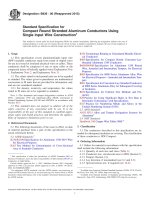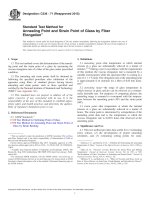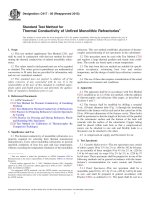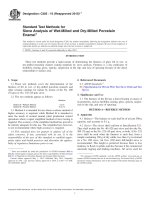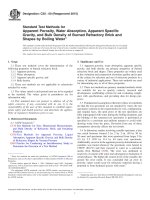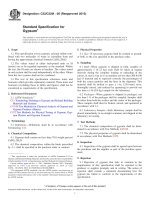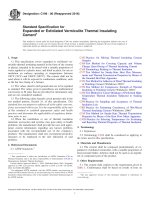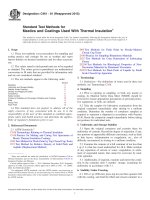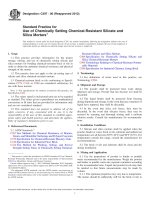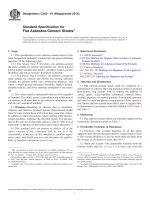Astm c 20 00 (2015)
Bạn đang xem bản rút gọn của tài liệu. Xem và tải ngay bản đầy đủ của tài liệu tại đây (68.88 KB, 3 trang )
Designation: C20 − 00 (Reapproved 2015)
Standard Test Methods for
Apparent Porosity, Water Absorption, Apparent Specific
Gravity, and Bulk Density of Burned Refractory Brick and
Shapes by Boiling Water1
This standard is issued under the fixed designation C20; the number immediately following the designation indicates the year of original
adoption or, in the case of revision, the year of last revision. A number in parentheses indicates the year of last reapproval. A superscript
epsilon (´) indicates an editorial change since the last revision or reapproval.
This standard has been approved for use by agencies of the U.S. Department of Defense.
1. Scope
3. Significance and Use
1.1 These test methods cover the determination of the
following properties of burned refractory brick:
1.1.1 Apparent porosity,
1.1.2 Water absorption,
1.1.3 Apparent specific gravity, and
1.1.4 Bulk density.
3.1 Apparent porosity, water absorption, apparent specific
gravity, and bulk density are primary properties of burned
refractory brick and shapes. These properties are widely used
in the evaluation and comparison of product quality and as part
of the criteria for selection and use of refractory products in a
variety of industrial applications. These test methods are used
for determining any or all of these properties.
1.2 These test methods are not applicable to refractories
attacked by water.
3.2 These test methods are primary standard methods which
are suitable for use in quality control, research and
development, establishing criteria for and evaluating compliance with specifications, and providing data for design purposes.
1.3 The values stated in inch-pound units are to be regarded
as the standard. The values given in parentheses are for
information only.
1.4 This standard does not purport to address all of the
safety concerns, if any, associated with its use. It is the
responsibility of the user of this standard to establish appropriate safety and health practices and determine the applicability of regulatory limitations prior to use.
3.3 Fundamental assumptions inherent in these test methods
are that the test specimens are not attacked by water, the test
specimens conform to the requirements for size, configuration,
and original faces, the open pores of the test specimens are
fully impregnated with water during the boiling treatment, and
the blotting of the saturated test specimens is performed as
specified in a consistent and uniform manner to avoid withdrawing water from the pores. Deviation from any of these
assumptions adversely affects the test results.
2. Referenced Documents
2.1 ASTM Standards:2
C134 Test Methods for Size, Dimensional Measurements,
and Bulk Density of Refractory Brick and Insulating
Firebrick
C830 Test Methods for Apparent Porosity, Liquid
Absorption, Apparent Specific Gravity, and Bulk Density
of Refractory Shapes by Vacuum Pressure
E691 Practice for Conducting an Interlaboratory Study to
Determine the Precision of a Test Method
3.4 In laboratory studies involving castable specimen, a bias
was noted between formed 2 by 2 by 2–in. (50 by 50 by
50–mm) and specimens that were quartered from larger 9 by
4.5 by 2.5 (228 by 114 by 64 mm) cast specimens.
Additionally, an error in the apparent porosity determination on
castables was found whenever the specimens were heated to
1500°F (816°C) and then exposed to water as a saturation
media (Test Method C830). The error was attributed to
reactivity of cement with water and subsequent re-hydration of
cement phases. The higher the cement level of the castable, the
greater the error noted. It was concluded that an error in
porosity values could occur for refractory materials having a
potential to form hydrated species with water.3
1
These test methods are under the jurisdiction of ASTM Committee C08 on
Refractories and are the direct responsibility of Subcommittee C08.03 on Physical
Properties.
Current edition approved March 1, 2015. Published April 2015. Originally
approved in 1918. Last previous edition approved in 2010 as C20 – 00 (2010). DOI:
10.1520/C0020-00R15.
2
For referenced ASTM standards, visit the ASTM website, www.astm.org, or
contact ASTM Customer Service at For Annual Book of ASTM
Standards volume information, refer to the standard’s Document Summary page on
the ASTM website.
3
Supporting data have been filed at ASTM International Headquarters and may
be obtained by requesting Research Report RR:C08-1014.
Copyright © ASTM International, 100 Barr Harbor Drive, PO Box C700, West Conshohocken, PA 19428-2959. United States
1
C20 − 00 (2015)
5.3.1 Determine the weight, S, of each test specimen after
boiling and while suspended in water in grams to the nearest
0.1 g.
5.3.2 This weighing is usually accomplished by suspending
the specimen in a loop or halter of AWG Gage 22 (0.643-mm)
copper wire hung from one arm of the balance. The balance
shall be previously counter-balanced with the wire in place and
immersed in water to the same depth as is used when the
refractory specimens are in place.
3.5 Certain precautions must be exercised in interpreting
and using results from these test methods. All four property
values are interrelated by at least two of the three base data
values generated during testing. Thus, an error in any base data
value will cause an error in at least three of the property values
for a given test specimen. Certain of the properties, that is,
apparent specific gravity and bulk density, are functions of
other factors such as product composition, compositional
variability within the same product, impervious porosity, and
total porosity. Generalizations on or comparisons of property
values should only be judiciously made between like products
tested by these test methods or with full recognition of
potentially inherent differences between the products being
compared or the test method used.
5.4 Saturated Weight, W—After determining the suspended weight, blot each specimen lightly with a moistened
smooth linen or cotton cloth to remove all drops of water from
the surface and determine the saturated weight, W, in grams by
weighing in air to the nearest 0.1 g. Perform the blotting
operation by rolling the specimen lightly on the wet cloth,
which has previously been saturated with water, and then press
only enough to remove such water as will drip from the cloth.
Excessive blotting will induce error by withdrawing water
from the pores of the specimen.
4. Test Specimens
4.1 When testing 9-in. (228-mm) straight brick, use a
quarter-brick specimen by halving the brick along a plane
parallel to the 9 by 2-1⁄2 or 3-in. (228 by 64 or 76-mm) face and
along a plane parallel to the 4-1⁄2 by 2-1⁄2 or 3-in. (114 by 64 or
76-mm) face. Four of the surfaces of the resultant quarter-brick
specimen include part of the original molded faces.
6. Calculation
6.1 Exterior Volume, V—Obtain the volume, V, of the test
specimens in cubic centimetres by subtracting the suspended
weight from the saturated weight, both in grams, as follows:
4.2 When testing other refractory shapes, cut, drill, or break
from each shape a specimen having volume of approximately
25 to 30 in.3 (410 to 490 cm3). The specimen shall include
interior and exterior portions of the shape.
V, cm 3 5 W 2 S
(1)
NOTE 1—This assumes that 1 cm3 of water weighs 1 g. This is true
within about 3 parts in 1000 for water at room temperature.
4.3 Remove all loosely adhering particles from each specimen.
6.2 Volumes of Open Pores and Impervious Portions—
Calculate the volume of open pores and the volume of the
impervious portions of the specimen as follows:
5. Procedure
5.1 Dry Weight, D:
5.1.1 Dry the test specimens to constant weight by heating
to 220 to 230°F (105 to 110°C) and determine the dry weight,
D, in grams to the nearest 0.1 g.
5.1.2 The drying procedure may be omitted only when the
test specimens are known to be dry, as may be the case with
samples taken directly from kilns.
5.1.3 The drying of the specimens to constant weight and
the determination of their dry weight may be done either before
or after the saturation operation (Section 6). Usually, the dry
weight is determined before saturation. However, if the specimens are friable or evidence indicates that particles have
broken loose during the saturating operation, dry and weigh the
specimens after the suspended weight, S, and the saturated
weight, W, have been determined, as described in Sections 5.3
and 5.4. Use this second dry weight in all appropriate calculations.
Volume of open pores, cm3 5 W 2 D
3
Volume of impervious portion, cm 5 D 2 S
(2)
(3)
6.3 Apparent Porosity, P—The apparent porosity expresses as a percentage the relationship of the volume of the
open pores in the specimen to its exterior volume. Calculate P
as follows:
P, % 5 @ ~ W 2 D ! /V # 3 100
(4)
6.4 Water Absorption, A—The water absorption, A, expresses as a percentage the relationship of the weight of water
absorbed to the weight of the dry specimen. Calculate A as
follows:
A, % 5 @ ~ W 2 D ! /D # 3 100
(5)
6.5 Apparent Specific Gravity, T—Calculate the apparent
specific gravity, T, of that portion of the test specimen which is
impervious to boiling water as follows:
5.2 Saturation:
5.2.1 Place the test specimens in water and boil for 2 h.
During the boiling period, keep them entirely covered with
water, and allow no contact with the heated bottom of the
container.
5.2.2 After the boiling period, cool the test specimens to
room temperature while still completely covered with water.
After boiling keep the specimens immersed in water for a
minimum of 12 h before weighing.
T 5 D/ ~ D 2 S !
(6)
6.6 Bulk Density, B:
6.6.1 The bulk density, B, of a specimen in grams per cubic
centimetre is the quotient of its dry weight divided by the
exterior volume, including pores. Calculate B as follows:
B, g/cm 3 5 D/V
(7)
6.6.2 This test method of determining bulk density is useful
for checking bulk density values obtained by direct measurement of Test Methods C134.
5.3 Suspended Weight, S:
2
C20 − 00 (2015)
TABLE 2 Precision and Relative Precision
NOTE 2—While it is more accurate than the direct measurement
method, and generally gives higher values (by about 0.02 to 0.04), the
direct measurement method is better suited for plant and field testing,
since it is a less involved technique. The present method is preferable for
specimens that are branded deeply or irregular in contour.
Precision
Test
Property
7. Report
Absorption, %
Apparent porosity, %
Bulk density
Apparent specific gravity
7.1 For each property, report the individual values obtained.
7.2 Report apparent porosity and water absorption results to
one decimal place, and apparent specific gravity and bulk
density results to two decimal places.
B
C
Grand
Average
Absorption avg, %
Standard deviation within
Standard deviation between
Relative standard deviation, %
Xj
Sr
SL
Vr
VL
12.37
0.1102
0.0866
0.89
0.70
6.67
0.0776
0.0562
1.16
0.84
4.83
0.075
0.0182
1.55
0.38
...
0.0876
0.0537
1.20
0.64
Apparent porosity, avg, %
Xj
Sr
SL
Vr
VL
22.24
14.44
0.1893 0.1559
0.0000 0.0000
0.85
1.08
0.00
0.00
11.22
0.1696
0.0000
1.51
0.00
...
0.1716
0.0000
1.15
0.00
Xj
Sr
SL
Vr
VL
1.799
0.00189
0.00274
0.105
0.152
2.172
0.00458
0.00296
0.211
0.136
2.327
0.00206
0.00267
0.089
0.115
...
0.00284
0.00279
0.135
0.134
Xj
Sr
SL
Vr
VL
2.314
0.00577
0.00442
0.249
0.191
2.539
0.00634
0.00468
0.250
0.184
2.621
0.00495
0.00438
0.189
0.167
...
0.00569
0.00449
0.229
0.181
Bulk density, avg
Apparent specific gravity, avg
% Ir
% IR
0.25
0.49
0.008
0.016
0.29
0.49
0.011
0.021
3.40
3.25
0.38
0.65
3.9
3.25
0.54
0.83
(8)
8. Precision and Bias
8.1 Interlaboratory Test Data—An interlaboratory roundrobin test was conducted between six laboratories on three
different types of refractories. The same four specimens of each
material were sent from laboratory to laboratory, thereby
eliminating sample variation. Each laboratory conducted two
separate tests using two different operators, Operators A and B.
The components of variance expressed as standard deviation
and relative standard deviation (coefficient of variation) for
absorption, apparent porosity, bulk density, and apparent specific gravity (ASG) were as given in Table 1.
TABLE 1 Interlaboratory Test Data
Material
Reproducibility
IR
P, % 5 A 3 B
NOTE 3—When values are reported for water absorption but not for
porosity, it is suggested that the report shall also give the results for bulk
density. This makes it possible to calculate the corresponding apparent
porosity values as follows:
A
Relative Precision
Repeatability,
Ir
NOTE 4—All statistical calculations are in accordance with Practice
E691.
8.2 Precision—For the components of variation given in
8.1, a test result on any one sample should be considered
significantly different at a confidence level of 95 %, if the
repeatability used for reproducibility exceeds the precision data
given in Table 2.
8.3 Bias—No justifiable statement on bias is possible since
the true physical property values of refractories cannot be
established by an accepted reference material.
9. Keywords
9.1 apparent porosity; apparent specific gravity; bulk density; refractory shapes; water absorption; water boil
ASTM International takes no position respecting the validity of any patent rights asserted in connection with any item mentioned
in this standard. Users of this standard are expressly advised that determination of the validity of any such patent rights, and the risk
of infringement of such rights, are entirely their own responsibility.
This standard is subject to revision at any time by the responsible technical committee and must be reviewed every five years and
if not revised, either reapproved or withdrawn. Your comments are invited either for revision of this standard or for additional standards
and should be addressed to ASTM International Headquarters. Your comments will receive careful consideration at a meeting of the
responsible technical committee, which you may attend. If you feel that your comments have not received a fair hearing you should
make your views known to the ASTM Committee on Standards, at the address shown below.
This standard is copyrighted by ASTM International, 100 Barr Harbor Drive, PO Box C700, West Conshohocken, PA 19428-2959,
United States. Individual reprints (single or multiple copies) of this standard may be obtained by contacting ASTM at the above
address or at 610-832-9585 (phone), 610-832-9555 (fax), or (e-mail); or through the ASTM website
(www.astm.org). Permission rights to photocopy the standard may also be secured from the Copyright Clearance Center, 222
Rosewood Drive, Danvers, MA 01923, Tel: (978) 646-2600; />
3
